How To Promote a Referral Program For Your Shopify Stores? (15+ Free & Paid Tactics That Work)

In today’s fiercely competitive direct-to-consumer landscape, knowing how to promote a referral program effectively can be the difference between thriving and merely surviving. With customer acquisition costs rising across all channels: Facebook ads averaging $18.68 per conversion and Google Ads climbing to $48.96 for e-commerce, Shopify store owners need smarter, more cost-effective growth strategies.
Building a referral program is just the first step. The real challenge lies in actively promoting it to drive consistent, quality referrals. The psychology of word-of-mouth marketing is powerful: 92% of consumers trust recommendations from people they know over all forms of advertising. When combined with Shopify’s robust ecosystem of apps, automation tools, and marketing integrations, referral programs become a low-cost acquisition channel that compounds over time.
This comprehensive guide reveals 15+ proven tactics to promote your Shopify referral program, from free organic methods to paid strategies and automated approaches that scale with your business.
Why Referral Programs Work for Shopify Stores?
The psychology behind successful referral programs taps into fundamental human behaviors. Word-of-mouth recommendations trigger peer trust and social proof – two critical factors that significantly boost conversion rates and customer lifetime value. When a satisfied customer shares your brand with friends, they’re essentially providing a personal endorsement that carries far more weight than traditional advertising. Back to reality, Shopify stores are particularly well-positioned to leverage referral programs because:
- Low cost-per-acquisition: Referral programs typically cost 5-10x less than paid advertising channels
- Faster compounding growth: Each satisfied customer becomes a potential acquisition channel
- Perfect fit for DTC/omnichannel: Referral links work seamlessly across email, social, mobile, and in-person interactions
- Built-in tracking: Shopify’s analytics ecosystem makes measuring referral ROI straightforward
- Unlimited integration with 3rd party tools: Shopify’s diverse app ecosystem makes it easy to amplify referral programs. Integrate with Mailchimp or Klaviyo for automated campaigns, use tools like Fomo for real-time social proof, and add loyalty or push notification apps to build a seamless multi-channel growth engine.
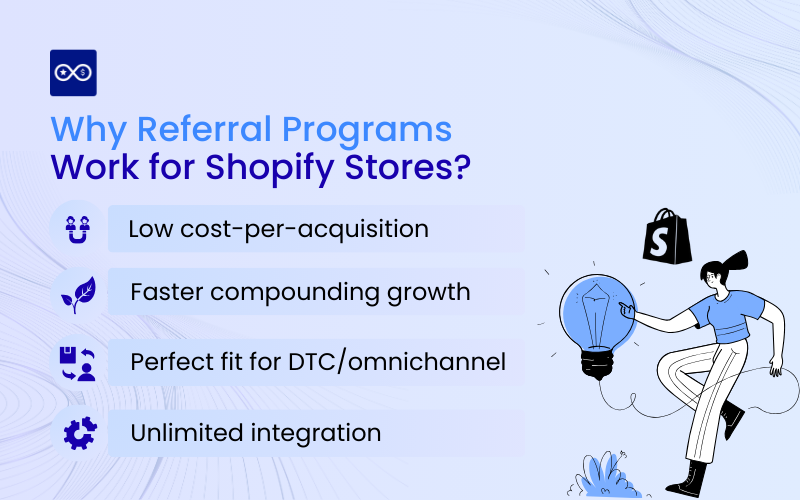
Core Principles of High-Performing Referral Programs
Before diving into referral program promotion tactics, understanding these foundational principles ensures your program is worth promoting in the first place.
Double-Sided Incentives That Motivate Both Sides
Two-sided rewards consistently outperform one-sided programs by creating motivation for both the referrer and the new customer. When both parties benefit, sharing becomes more natural and conversion rates increase significantly.
Effective Shopify e-commerce incentives include:
- Store credit (20% higher engagement than cash rewards)
- Percentage discounts (10-20% works well for most product categories)
- Free shipping (especially effective for brands with higher AOV)
- Tiered rewards that increase with more successful referrals
- Exclusive products or early access for top referrers
For example, Outdoor gear retailer Patagonia uses a tiered system where customers earn $20 store credit for their first referral, $30 for their third, and $50 for their fifth. This gamification approach reduces referral program stagnation and keeps participants engaged long-term.
Simplicity, Frictionless Sharing, & Instant Trackability
The three-click rule should govern your referral flow: customers should be able to share their referral link in three seamless actions or fewer. Complex processes kill participation rates faster than poor incentives.
Essential elements for frictionless sharing:
- Branded, memorable referral links (yourstore.com/refer-sarah)
- QR codes for easy mobile sharing
- Cross-device accessibility ensuring links work on web, mobile, and email
- One-click social sharing to popular platforms
- Auto sign-up from purchase confirmation pages
Modern referral apps can automatically enroll customers after their first purchase, eliminating the friction of manual sign-ups while maintaining compliance with privacy regulations.
Built-In Protection from Abuse
Fraud prevention is critical to program integrity and ROI. Common abuse patterns include self-referrals using different email addresses, coupon code sharing without genuine referrals, and organized fraud rings targeting new customer discounts.
Effective Shopify protection features include:
- Automatic fraud filters based on email patterns, IP addresses, and purchase behaviors
- Blocklisting capabilities for suspicious accounts
- Manual approval workflows for high-value rewards
- Purchase history verification before rewards are issued
- Velocity limits to prevent spam sharing
3 Main Channels That Help Promote Referral Programs for Your Store
In fact, if you operate Shopify stores, Shopify referral program apps will be a great tool to help you promote your campaign. The goal is to increase as many touchpoints along the purchase journey as possible. And based on that, there will be 3 main methods for you to develop your promotion strategy:
1. Email Flows
Automated referral emails invite customers to join, remind them of rewards, or update them on progress. For example, Bloop lets you customize campaign emails so every customer gets a clear nudge at the right time without extra manual work.
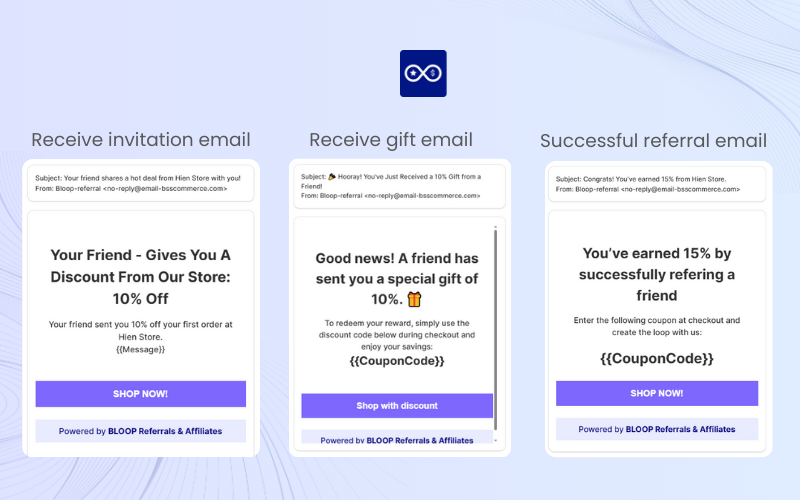
2. Landing page, Widgets & On-site Placement
Not every customer checks their email, which makes on-site visibility essential. By placing referral widgets and CTAs across your store, you make the program easy to find and act on during peak engagement moments. Some common placements include:
- Referral widget & referral landing page in your homepage or footer so customers can join anytime
- Friend offer popup after checkout to capture excitement while it’s fresh
- Join block embedded in product or account pages
- Friend offer page in Shopify where new customers can grab their discount
- Checkout extension that invites shoppers to refer before they finish buying
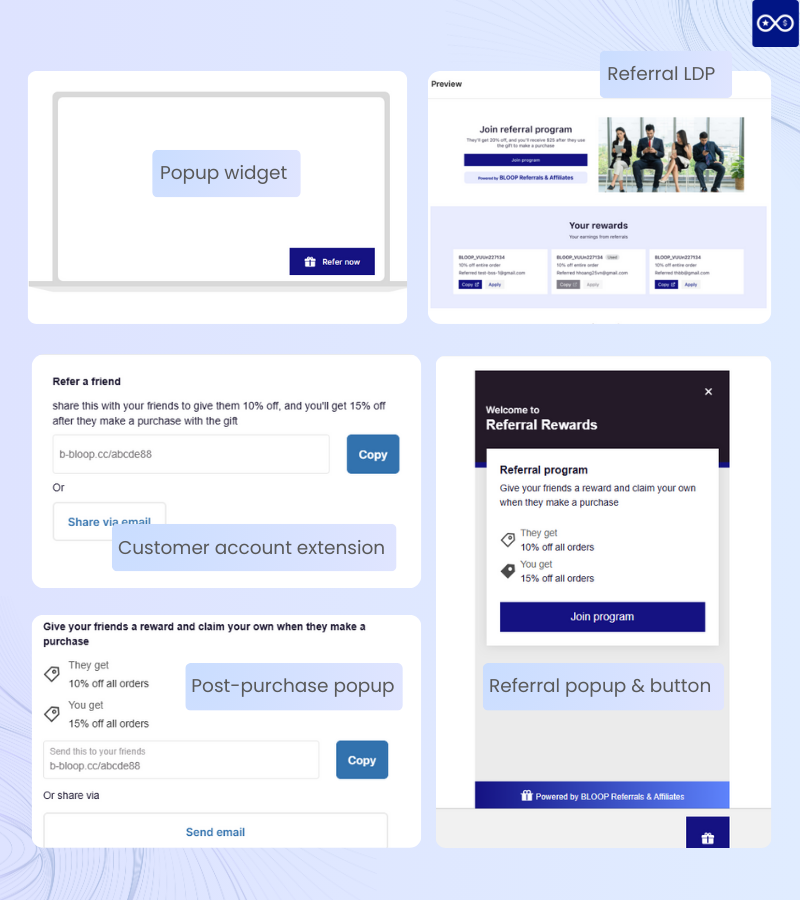
3. Third-party App Integrations
To truly scale, referral programs should connect seamlessly with the rest of your marketing stack. Shopify’s rich app ecosystem makes this possible by amplifying reach and streamlining tracking. Examples include:
- Email & Push: Tools like Klaviyo or Mailchimp let you personalize rewards and sync referral contacts directly into your marketing flows
- Ad Tracking: With Facebook Pixel or Google Ads, you can retarget friends who clicked a referral link but didn’t purchase yet
- Social Proof: Apps like Fomo show live notifications (“Anna just joined the program”), building trust and urgency
- Shopify Add-ons: Buy Button, Automation Flow, or Shopify Loyalty program app extend your referral program with embedded widgets, automated triggers, or loyalty point rewards
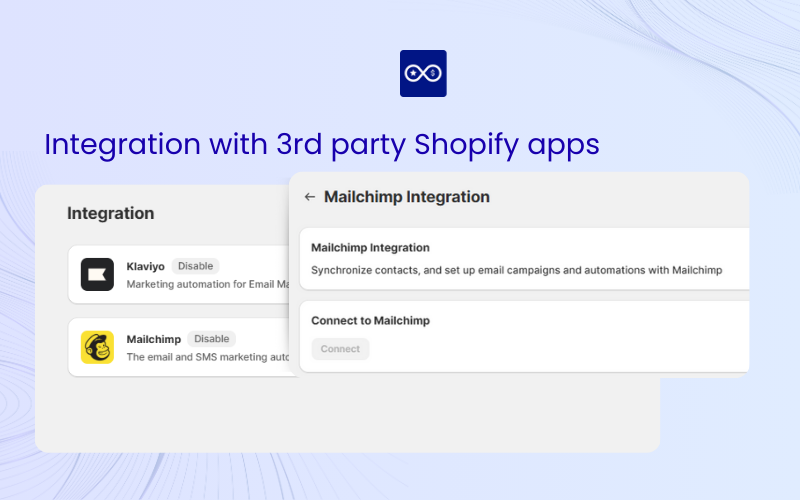
15+ Free & Paid Tactics to Promote Your Shopify Referral Program
Once you’ve set up the foundation, the next step is driving awareness. Customers won’t join if they don’t know your referral program exists, so promotion is just as critical as the rewards themselves. Below are over ten proven tactics, split into free, paid, and automated approaches, that you can mix and match depending on your budget and goals.
Free Tactics
If you’re just starting out or want to maximize ROI, these no-cost strategies help you tap into touchpoints you already own:
1. Strategic Pop-ups & Banners on High-Traffic Pages: Place referral program announcements on your cart page, thank-you page, and account dashboard where customers are already engaged. These high-intent moments have conversion rates 3-5x higher than homepage placements.
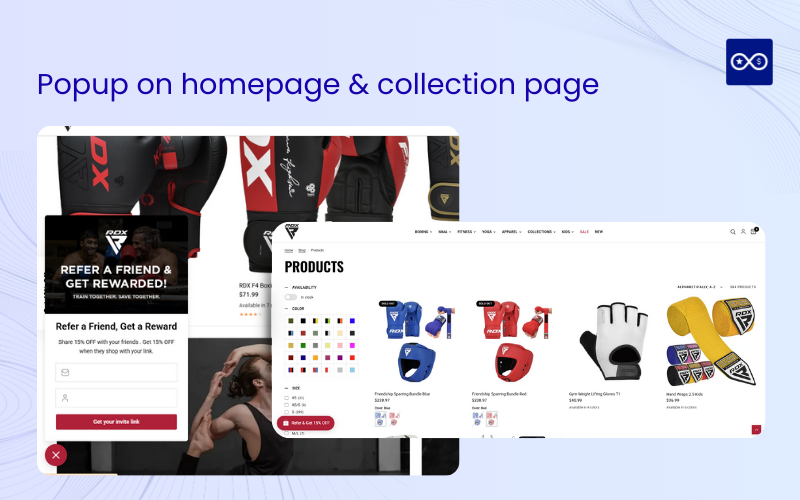
2. Always-Visible Referral CTA in Navigation & Footer: Make your referral program discoverable by adding a persistent “Refer Friends” link in your main navigation and footer. This passive promotion catches customers when they’re browsing organically.
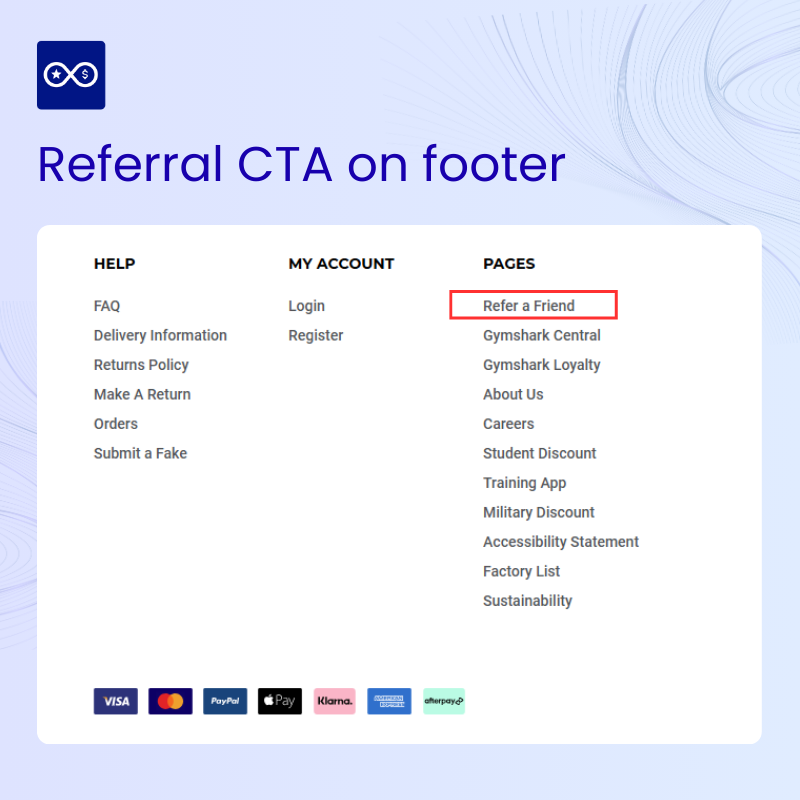
3. Customer Account Extension: Create a dedicated referral section in customer accounts where users can access their unique links, track rewards, and see referral history. This becomes a regular touchpoint for program engagement.
4. Email Marketing Integration: Launch with a dedicated announcement email to your entire list, then add referral messaging to newsletters, post-purchase sequences, and win-back campaigns. Segment based on purchase history for higher relevance.
5. Team Email Signatures: Add referral links to support, sales, and founder email signatures. Every customer interaction becomes a subtle promotion opportunity without extra effort.

6. Social Media Announcements: Create posts showcasing your referral program with real customer testimonials. User-generated content featuring rewards or success stories performs particularly well on Instagram and Facebook.
7. Physical Insert Cards in Orders: Include QR code cards in shipped orders with clear instructions and incentives. This touchpoint reaches customers at peak satisfaction moments when they’re most likely to share.
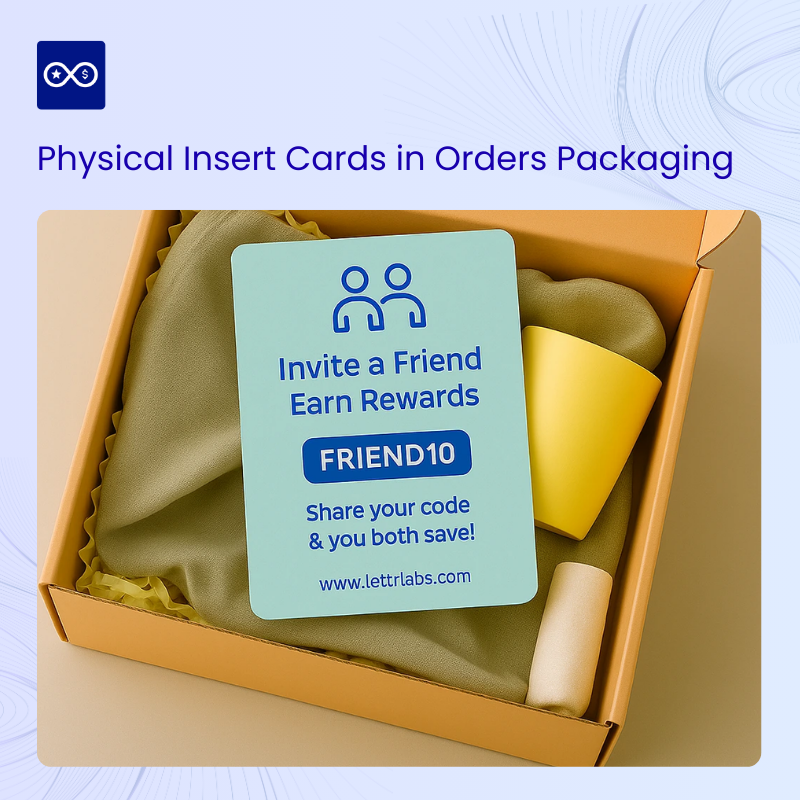
8. Customer Service Scripts: Train support teams to mention referral programs after resolving issues positively or when customers express satisfaction. This personal touch often converts better than automated messages.
Paid Tactics
When you’re ready to scale faster, paid promotion ensures your referral program reaches beyond existing customers:
1. Paid Social Retargeting to Past Customers: Create Google/Meta ads specifically targeting previous purchasers with referral program messaging. Use lookalike audiences based on your best customers for expansion.
2. Influencer & UGC Seeding Programs: Partner with micro-influencers (1K-100K followers) to showcase your referral program. Provide them with unique referral codes and track performance to identify the most effective partnerships.
3. SMS Marketing Blasts: Send targeted SMS messages to your subscriber list announcing referral programs or limited-time bonus rewards. Keep frequency controlled (maximum once per month) to avoid opt-outs.
Automated & Data-Driven Tactics
Finally, automation ensures your referral program keeps running in the background, continuously engaging customers at the right moments:
1. Milestone-Triggered Email Campaigns: Set up automated emails that boost referrals when customers hit specific milestones: second purchase, positive review submission, or high engagement scores.
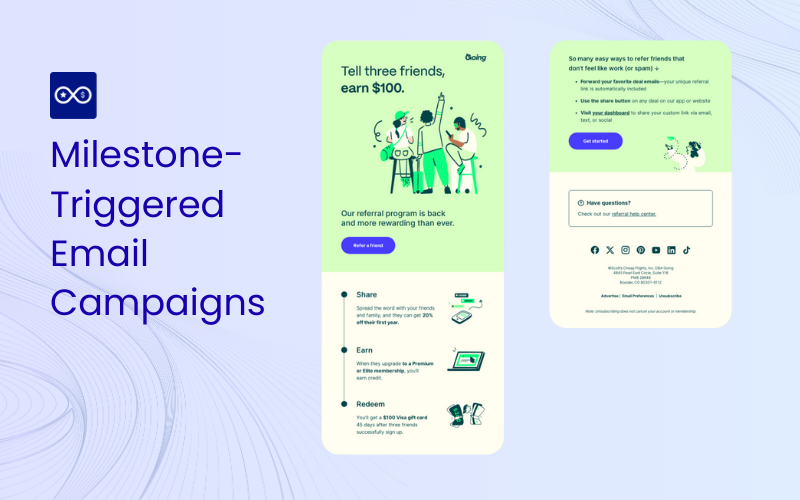
2. Post-Purchase Automated Reminders: Configure reminder sequences that activate 7, 30, and 90 days after purchase when satisfaction is high but recency is still strong.
3. Behavioral Trigger Pop-ups: Use on-site behavior (time spent, pages visited, cart additions) to trigger referral program pop-ups at optimal engagement moments.
4. A/B Testing Programs: Continuously test referral messaging, incentive amounts, visual designs, and timing to optimize conversion rates and sharing behavior.
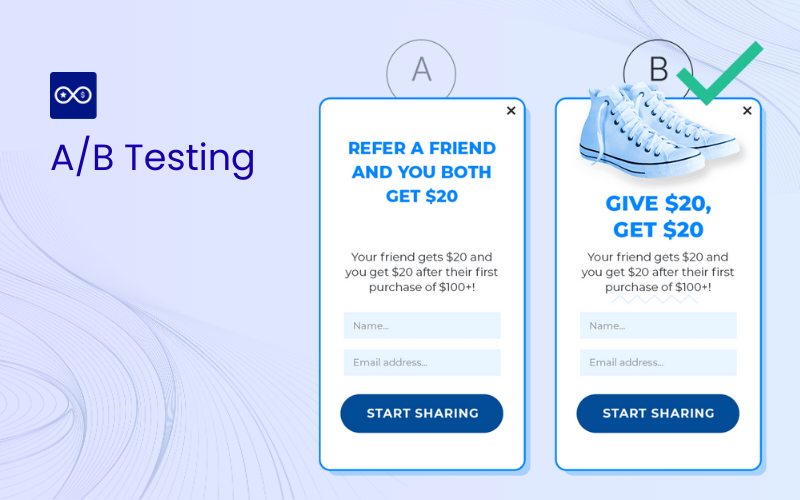
Pro Tips On How to Promote a Referral Program for Your Store
Once you’ve set up the basics and started testing free, paid, and automated tactics for promoting a referral program, the next step is to maximize impact through smart optimization:
- Run Limited-Time Boosted Reward Events: Create urgency by doubling referral rewards during peak sales seasons (Black Friday, holiday shopping, back-to-school). These campaigns can increase sharing activity by 40-60% during promotional periods.
- Use VIP/Loyalty Tiers for Ongoing Referrals: Reward your best referrers with exclusive perks: early access to new products, special discounts, or recognition in your community. This creates a flywheel effect where top advocates continue promoting your brand.
- Activate Community Channels: If you have Facebook Groups, Discord servers, or other community spaces, celebrate top referrers publicly and create friendly competition around referral achievements.
Case Study: Electronics retailer TechGear implemented SMS post-purchase referral asks combined with persistent dashboard banners, resulting in a 40% increase in referral sharing within 3 months. Their key insight was timing the SMS 24 hours after delivery confirmation when satisfaction was highest.
5 Mistakes to Avoid When Promoting Referral Programs
Even the best-designed referral program can fall flat if it’s promoted poorly. To make sure your efforts actually drive sustainable growth, watch out for these common pitfalls:
- “Set and Forget” Approach: Launching without ongoing promotion and reminders leads to program stagnation within 60 days.
- Complicated or Non-Transparent Rewards: If customers can’t easily understand how rewards work, they won’t participate or share.
- Asking Too Early in the Relationship: Requesting referrals before customers have experienced value destroys trust and can damage brand perception.
- Ignoring Fraud and Abuse: Failing to implement proper controls allows bad actors to drain your program budget while providing no genuine customer acquisition.
- No Performance Analysis: Without measuring key metrics and optimizing based on data, even good programs underperform their potential by 50% or more.
FAQs About How to Promote Referral Programs For Shopify stores
After positive experiences: post-purchase confirmation, delivery confirmation, positive review submission, or customer service resolution. Avoid asking during checkout or before customers have received value.
Store credit typically performs best for Shopify stores because it drives repeat purchases and increases customer lifetime value. Test different options based on your customer base and profit margins.
Use referral apps with built-in fraud detection, implement purchase history verification, set velocity limits on sharing, and manually review high-value or suspicious referral claims.
Multiple touchpoints work best: launch announcement, post-purchase messages, quarterly newsletter mentions, and periodic win-back campaigns for non-participants. Avoid weekly frequency to prevent unsubscribes.
Focus on share rate (participation), conversion rate (effectiveness), customer acquisition cost per referral, and the lifetime value differential between referred and non-referred customers.
Launch, Promote & Optimize Your Shopify Referral Program Fast with Bloop
Modern referral management requires automation, analytics, and integration capabilities that manual systems can’t provide. Dedicated Shopify referral apps offer:
- Quick launch capability: Set up fully branded, automated referral flows in minutes rather than weeks
- Built-in fraud detection: Automatic filters and approval workflows protect program integrity
- Real-time analytics: Track performance metrics and optimize campaigns based on data
- Marketing stack integration: Seamless connection with Klaviyo, Mailchimp, SMS platforms, and Shopify Flow
- Automated enrollment: Customers join your program automatically after purchase
- Reward delivery: Automatic discount codes and store credit distribution
- Performance tracking: Detailed reporting on referral sources, conversion rates, and ROI
For Shopify store owners looking to implement these promotion tactics without technical complexity, Bloop referrals & affiliate provide the infrastructure needed to execute sophisticated referral marketing campaigns at scale.
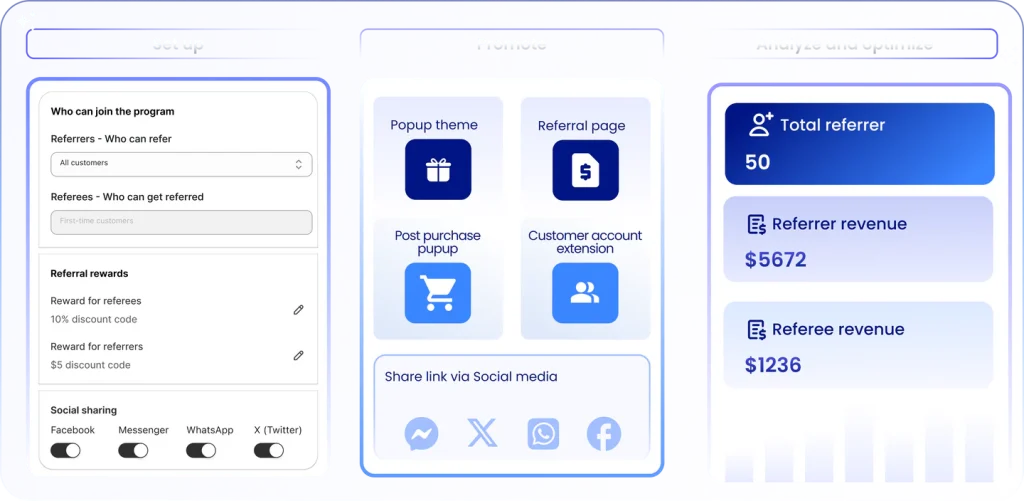
Conclusion
Learning how to promote a referral program effectively transforms it from a passive feature into an active growth engine for your Shopify store. The tactics outlined in this guide, from free organic promotion methods to paid strategies and automated approaches, provide a comprehensive framework for driving consistent referral activity.
Remember that promotion is ongoing, not a one-time launch activity. The most successful Shopify stores treat referral program promotion as an integral part of their customer communication strategy, weaving referral opportunities naturally into the entire customer journey. Start by implementing 2-3 tactics from the free category, measure their performance, and gradually expand your promotion efforts based on what resonates with your specific audience. With consistent promotion and optimization, referral programs typically reduce customer acquisition costs by 30-50% while bringing in customers with higher lifetime value and retention rates.
Ready to turn your customers into your most effective marketing channel? Explore how Bloop can help you quickly implement these promotion tactics with automated referral flows, built-in fraud protection, and seamless Shopify integration. Your next growth breakthrough might be just one referral away.